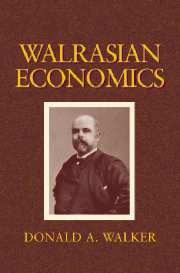Book contents
- Frontmatter
- Contents
- Preface
- Introduction
- Part I Walras's ideas
- 1 General philosophy and methodology
- 2 Economic philosophy and methodology
- 3 Methods of evaluation of economic theory
- 4 Human nature
- 5 Basic sub-models
- 6 Rationale for the written pledges sketch and its characteristics
- 7 Some bibliographical remarks
- 8 The definitive bibliography of the writings of Léon Walras
- Part II Walras's influence
- References
- References and Bibliography for Chapter 11
- Index
6 - Rationale for the written pledges sketch and its characteristics
Published online by Cambridge University Press: 02 September 2009
- Frontmatter
- Contents
- Preface
- Introduction
- Part I Walras's ideas
- 1 General philosophy and methodology
- 2 Economic philosophy and methodology
- 3 Methods of evaluation of economic theory
- 4 Human nature
- 5 Basic sub-models
- 6 Rationale for the written pledges sketch and its characteristics
- 7 Some bibliographical remarks
- 8 The definitive bibliography of the writings of Léon Walras
- Part II Walras's influence
- References
- References and Bibliography for Chapter 11
- Index
Summary
The problem and Walras's solution
A review of the problem
It has been seen in Chapter 5 that Walras explained, in reference to reality and to his mature comprehensive model (see, for example, 123, 1877, pp. 253, 255; 176, 1889, pp. 235, 238, 294; § 209, p. 315; § 212, p. 319; § 258, p. 401), that production and exchange occur at disequilibrium prices, varying as prices change during the course of the adjustment of the markets toward their equilibrium set of variables. In the model, holdings of goods and money are parameters for individual static supply and demand functions. Disequilibrium transactions alter the distribution of goods and money, resulting in changes in those functions. Disequilibrium production alters the amounts of goods and hence the holdings of goods, and thus also changes supply and demand functions. Walras came to realize with increasing clarity that those disequilibrium phenomena create a problem for the logical structure of his work, considered in relation to his equation system. Inasmuch as the equations of supply and demand have parameters that are actually endogenous variables in the model, their solutions – prices, rates of employment of resources, incomes, outputs, and quantities traded – are not the values toward which the model actually converges. The mature comprehensive model is therefore non-virtual in disequilibrium as well as in regard to what takes place when the equilibrium prices are quoted.
- Type
- Chapter
- Information
- Walrasian Economics , pp. 173 - 196Publisher: Cambridge University PressPrint publication year: 2006



